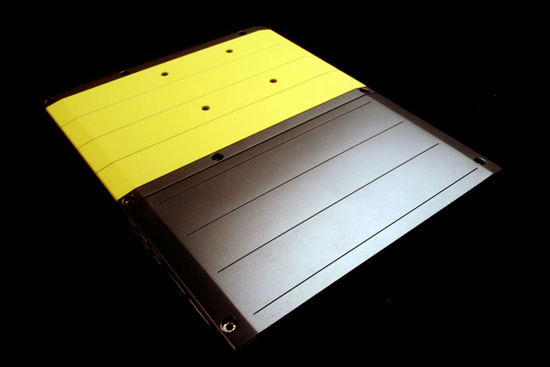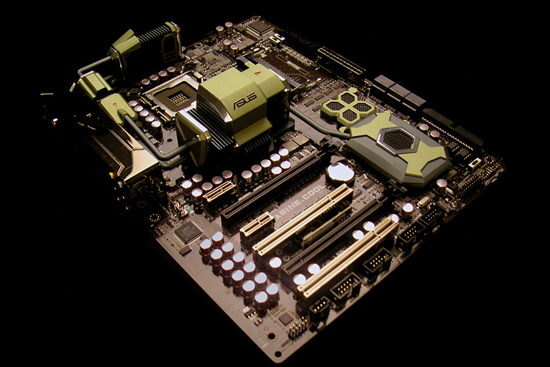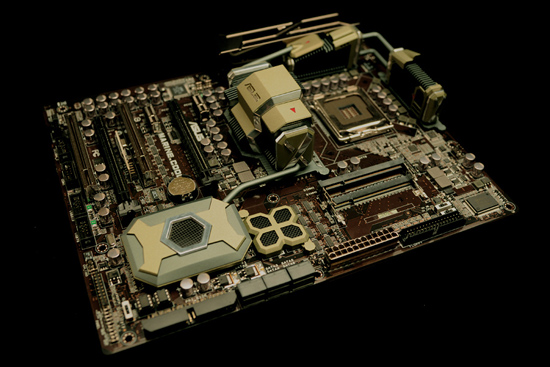CeBIT 2009 - ASUS Marine Cool
by Gary Key on February 25, 2009 10:22 PM EST- Posted in
- Gary's First Looks
CeBIT 2009 officially starts next Tuesday, but we already have some early coverage from cold and wet Hannover, Germany. ASUS has given us an early look at their Marine Cool design concept. Just like concept cars at the major automobile shows, this particular motherboard is meant to introduce new design ideas into a rather "me too" market.

ASUS was rather coy about what design and layout aspects will eventually make their way into future motherboard products. However, one major design change we expect to see in upcoming boards is the new back plate that utilizes "micro-porous ceramic" technology to dissipate heat quicker and to provide structural integrity to the motherboard.


The new heatpipe system also improves chipset and PWM cooling compared to shipping products, while the layout receives a few tweaks for usability. We are not too wild about the SO-DIMM slots for a performance oriented system, but they do save real estate space and perform well on mainstream systems. The heatsink design and technology behind it (cannot comment further, yet) is certainly an item that we liked. In fact, the design reminded us of a few design elements from Space:1999 (yes, some of us are that old).
ASUS is interested in your opinions, so leave your thoughts in our comments section. In the meantime, we will have more information about the Marine Cool technology in upcoming coverage. auf Wiedersehen!
Updated Press Information from ASUS - "ASUS MARINE COOL Motherboard: Revolutionary Design and Advanced Innovations to Deliver the Ultimate in Stability and Durability - The ASUS MARINE COOL is a conceptual motherboard that addresses the most demanding of usage scenarios. The front features a metal heat-pipe module to provide exceptional heat transference and dissipation for core components. Set flush on the back of the PCB, the backplate makes full use of micro-porous ceramic technology to provide a larger surface area—facilitating heat away from the PCB for highly effective thermal dissipation. Together, these revolutionary designs improve heat dissipation by up to 2 fold. The ASUS MARINE COOL also features an on-board uninterruptible power supply (UPS)—a built-in polymer battery (gray portion of the backplate) that averts damage from unexpected blackouts. Furthermore, built-in server-standard Failover Memory (under the flower shaped object) guarantees system boot, regardless of incompatible or faulty memory."
















27 Comments
View All Comments
tdktank59 - Thursday, February 26, 2009 - link
I don't get why they even bother putting things right below the PCI-E x16 / x8 slots... When most GPX Cards these days take 2 slots...Basically if you were to put in 2 2 slot cards for crossfire/sli you would be screwed if you needed more then 1 PCI-E x1 or a PCI slot... Basically that would be a sound card right there... without much room for breathing for the graphics card if PCI...If I remember right most if not all boards are designed this way...
But on these Hi-End boards why bother... You know if the user can afford a $200+ board that these slots are just a waste or space and that means more complex wiring to get those integrated...
Im not saying get rid of the gap one but the one right below the PCI-E x16... The gap one allows for the breathing room needed for cooling.
Other than that SO-DIMM anything of a good size costs an arm and a leg... Go back to DDR2 or DDR3 for gods sake... Unless you can get those sodims down in cost to be comparable with ddr2 and at the 4GB mark...
Now if the price was comprable and they were in 4GB capacities then i can see why they would use them but come on... a 4GB so-dimm at a decent speed is going to run you a couple hundred at least...
icingdeath88 - Thursday, February 26, 2009 - link
If it weren't for the fact that even if it were made, they'd take away a ton of the cool stuff that they put in the concept and make it ridiculously expensive, this is a really cool exercise.Also, I don't see why so-dimms are lower performance by necessity. No one ever really tried to make em fast, just low-power for laptops/imbedded type stuff. Good idea try em out, sometimes it's good to be different just for the sake of being different. Plus, I mean, if we could fit 2x the dimms in the same area, that'd sure help to save money on ram, seeing as 8 2gig sticks are cheaper than 4 4gig sticks for example. sure would make getting that 16 gigs you could theoretically use cheaper, more attainable. doesn't help those of us who only use 2 of the 4 slots we have anyway, but you see what I'm sayin.
JarredWalton - Thursday, February 26, 2009 - link
There are two fundamental issues I see with the use of SO-DIMMs on this board:1) Slightly lower performance (top SO-DIMMs are DDR2-800 and DDR3-1066 if I'm not mistaken, and latency is never as high as on desktop RAM). Honestly, this isn't a deal-breaker for me, but problem #2 is...
2) Only *two* SO-DIMM slots means you'll be stuck at a maximum of 2x2GB RAM for all intents and purposes. That's unacceptable, especially on a board that looks like it will probably retail for over $400. (Hopefully I'm wrong on that, but I somehow doubt it.)
mmntech - Thursday, February 26, 2009 - link
There are DDR3-1333 SO-DIMM chips. Prices and CAS latencies are the same as regular DIMMs, maybe slightly more expensive.On the second point, I agree. For an HTPC maybe but not for something being marketed as a gaming system. Using laptop memory for a desktop board is a vary odd choice.
afkrotch - Thursday, February 26, 2009 - link
As speeds increase, so does heat. How many SO-DIMMs you see with heatspreaders? Let alone a gap between slots to support it.Also SO-DIMMs are more costly. Yes, they are still inexpensive, but you get same amount of memory, lower performance, while paying a higher cost. A less for more scenario.
I'm not a fan of these heatpipes connecting the mosfets, nb, and sb. I watercool and I end up having to cut these heatpipes.
The weird backplate might need to have a open spot under the processor area. For heatsinks/waterblocks that use their own backplate.
The motherboard would be fine for your random PC shops, like Northwest Falcon or something. Many of your home system builders will probably be fine with it too. Your enthusiasts probably wouldn't touch it with a 10 foot pole. I know I wouldn't.
kfour - Thursday, February 26, 2009 - link
I love the backplate for functionality and the new heatsink looks. That SO-DIMM slot just wouldnt work for me at all though. Looking forward to the next design with more conventional desktop RAMblyndy - Thursday, February 26, 2009 - link
"8 2gig sticks are cheaper than 4 4gig sticks"Kingston 1x1GB DDR2-800 CAS-6 DIMM: $12.49
Kingston 1x2GB DDR2-800 CAS-6 DIMM: $23.99
Kingston 1x4GB DDR2-800 CAS-6 DIMM: $99.99
(@ Newegg)
True... Wow that premium is way bigger than I was expecting!
Although there are those of the opinion that more DIMMs = less stability. I don't know how true that is though.
On the other hand you could to quad-channel! (but defeat the space-savings)
I think it would be in the industries interest to see desktop mobos start to use SO-DIMM. Consolidation onto SO-DIMM would mean less product-lines, less manufacturing equipment, less cost per failed module and ultimately less costs.
Provided that there are no inherent performance disadvantages to SO-DIMM, I think that consolidating onto SO-DIMM would benefit everyone.